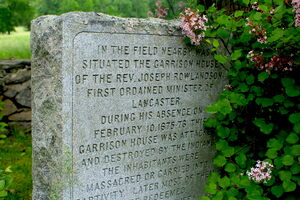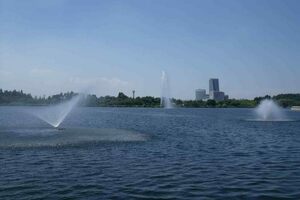Mary Rowlandson’s Monument in Lancaster, Massachusetts

The site of the former 17th-century garrison house of Rev. Joseph Rowlandson and his family is wonderfully bucolic, set beneath a canopy of shade trees and tucked behind a handsome low stone wall. But the scene was much different during King Philip’s War.
It was from this place on February 10, 1676, that Mary Rowlandson and three of her children, Joseph, Mary, and Sarah, were kidnapped during an attack by members of the Narragansett, Wampanoag, and Nashaway/Nipmuc. Such raids were not uncommon, as Native Americans often clashed with colonists.
For nearly 12 weeks, Rowlandson traveled with her captors through the forests of New England. Sarah died from her injuries a week into the ordeal. Mary and Joseph were separated from their mother and were marched separately through the woods. Eventually, a ransom was raised and paid. Rowlandson and her children were released at Redemption Rock in Princeton, Massachusetts.
Situated along busy Main Street/Route 70, a monument to the Rowlandsons’ grief and struggle beckons visitors to follow the adjacent dirt driveway into a verdant field. There, just steps from beautiful 19th-century homes and a stone’s throw from the stunning Thayer Conservatory, one can imagine the attack and kidnapping that became part of the historic fabric of Colonial America.
From the safety and security of her new home in Boston several years after her ordeal, Mary Rowlandson wrote a memoir. That book, A Narrative of the Captivity and Restoration of Mrs. Mary Rowlandson, made her somewhat of a literary sensation.
The former captive wrote about the tribulations she endured, including burying her daughter, being sold among Native Americans, witnessing her captors attack other towns, and suffering food deprivation. Upon publication in 1682, Rowlandson’s book was instantly popular among her fellow colonists. Four editions of her captivity narrative were issued that first year, making it among the first American bestsellers.





